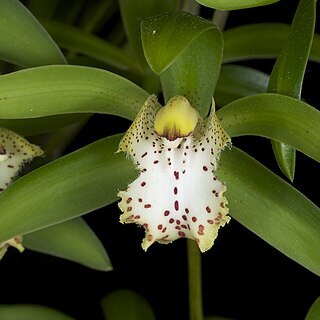Plants epiphytic or lithophytic, autotrophic. Pseudobulbs narrowly ellipsoid to narrowly ovoid, bilaterally flattened, 3-8 × 1.5-3 cm, partially enclosed in leaf bases. Leaves 4-6(-8), lorate, 35-60(-80) × 1.4-2.3 cm, articulate (4-)6-10 cm from base, apex acute. Inflorescence arising from near base of pseudobulb, arching or suberect, 45-60(-70) cm; rachis 7-14-flowered; floral bracts ovate-triangular, 3-4 mm. Flowers slightly fragrant, 11-12 cm in diam.; pedicel and ovary 30-50 mm; sepals and petals apple-green or yellowish green with a few deep red spots or occasionally tinged pale reddish brown at base; lip white or cream-yellow with chestnut spots and striations on lateral lobes and mid-lobe, becoming purplish red following pollination. Sepals suboblong, 50-55 × 15-17 mm, apex acute. Petals narrowly oblong-oblanceolate, 50-55 × 10-13 mm, apex acute; lip subelliptic, 45-50 mm, base fused to basal margins of column for 4-4.5 mm, 3-lobed; lateral lobes erect, ciliate; mid-lobe recurved, margin erose and undulate; disk sparsely minutely papillate or puberulent and densely so toward apices of lateral lobes, with 2 shortly hairy lamellae extending from base of lip to base of mid-lobe. Column arcuate, 33-40 mm, papillate or puberulent near base on ventral surface; pollinia 2, subtriangular. Capsule narrowly ellipsoid, 90-110 × ca. 40 mm. Fl. Jan-Apr, fr. Jun-Aug. 2n = 38*, 40*.
More
An orchid. It can grow attached to other plants. The false bulbs are narrowly oval and flattened and 3-8 cm long by 2-3 cm wide. They are partly enclosed by the leaf bases. There are 4-6 leaves. They are 35-60 cm long and 1-2 cm wide. They bend 6-10 cm from the base. The flowering shoot arises near the base of the false bulbs. There are 7-14 flowers. The flowers have a scent. They are green or yellowish green with red spots.
It is a tropical plant. It grows in trees in forests and on rocks along valleys between 1,100-2,700 m above sea level in southern China. In Northeastern India it grows at 4,300 m above sea level. In Sichuan and Yunnan.

